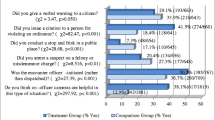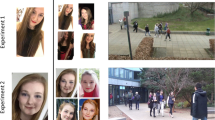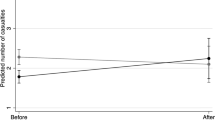Abstract
This paper examines factors contributing to the effectiveness of camera operators in urban camera surveillance. The use of camera surveillance has taken an enormous flight in the past decades. Despite this increase, its effectiveness is strongly debated. One reason for the disputed effectiveness may be that an understanding of how to use camera surveillance, including elements contributing to the effectiveness of camera operators, has not kept track with technological developments. This paper focuses on the role of expertise and familiarity with the environment on the effectiveness of camera operators to detect offenders in video footage from Rotterdam City Surveillance in the Netherlands. Results show no effect of expertise, but do show that familiarity with the location contributes to operator effectiveness and that camera operators seem to use different criteria for detecting and selecting suspects depending on the familiarity with the location. These results contribute to our understanding of operator effectiveness and offer guidelines for the training of camera operators. Implications are discussed.


Similar content being viewed by others
Notes
Here, speed of selection is not the same as the order in which suspects were pointed and selected. Speed was measured as the time between presenting the still and the selection of the next suspicious individual. Also note that because we use the speed of responses, we can only analyse hits and false alarms: correct and false rejections require inputs that were inherently not given.
We found no difference in expertise between participants with or without any false alarms, F < 1.
References
Cameron A, Kolodinski E, MayH, Williams N (2008) Measuring the effects of video surveillance on crime in Los Angeles. University of Southern California, USA. Available: http://www.library.ca.gov/crb/08/08-007.pdf
Carvalho SW, Block LG, Sivaramakrishnan S, Manchanda RV, Mitakakis C (2008) Risk perception and risk avoidance: the role of cultural identity and personal relevance. Int J Res Mark 25:319–326
Chi M, Glaser R, Farr M (1988) The nature of expertise. Erlbaum, Hillsdale
Closed-circuit television (n.d.) In: Wikipedia. Retrieved 13 Oct 2011, from http://www.en.wikipedia.org/wiki/closed-circuit_television
Ericsson KA, Krampe RT, Tesch-Römer C (1993) The role of deliberate practice in the acquisition of expert performance. Psychol Rev 100:363–406
Fanti KA, Vanman E, Heinrich CC, Avraamides MN (2009) Desensitization to media violence over a short period of time. Aggress Behav 35:179–187
Givens D (2008) Crime signals: how to spot a criminal before you become a victim?. St. Martin’s Press, New York
Gobet F, Simon HA (1996) Templates in chess memory: a mechanism for recalling several boards. Cogn Psychol 31:1–40
Gobet F, Simon HA (2000) Five-seconds or sixty? Presentation time in expert memory. Cogn Sci 24:651–682
Kraus SJ (1995) Attitudes and the prediction of behavior: a meta-analysis of the empirical literature. Pers Soc Psychol Bull 21:58–75
Lipshitz R, Ben Shaul O (1997) Schemata and mental models in recognition-primed decision making. In: Klein GA, Zsambok C (eds) Naturalistic decision making. Lawrence Earlbaum, Hillsdale, pp 293–303
Lousberg M, Langelaan S, Wetzer IM, van Hemert D (2009) Monitoring van afwijkend gedrag. TNO-DV 2009 C186 soesterberg. TNO, The Netherlands
Mohiyeddini C, Schmitt M (1997) Sensitivity to befallen injustice and reactions to unfair treatment in a laboratory situation. Soc Justice Res 10:333–352
Nunnally JC, Bernstein IH (1994) Psychometric theory, 3rd edn. McGraw-Hill, New York
Ratcliffe JH (2006) Video surveillance of public places. Problem oriented guides for police. Response Guides Ser 4:100
Ross KG, Klein GA, Thunholm P, Schmitt JF, Baxter HC (2004) The recognition-primed decision model. Mil Rev 1:6–10
Schaufeli WB, Salanova M, Gonzélez-Romá V, Bakker AB (2002) The measurement of engagement and burnout: a confirmative analytic approach. J Happiness Stud 3:71–92
Schmitt M, Gollwitzer M, Maes J, Arbach D (2005) Justice sensitivity: assessment and location in the personality space. Eur J Psychol Assess 21:202–211
Schraagen JM (1993) How experts solve a novel problem in experimental design? Cogn Sci 17:285–309
Shanteau J, Stewart TR (1992) Why study expert decision making? Some historical perspectives and comments. Organ Behav Human Decis Process 53:95–106
Swets JA, Tanner WP, Birdsall TG (1961) Decision processes in perception. Psychol Rev 68:301–340
Troscianko T, Holmes A, Stillman J, Mirmehdi M, Wright D, Wilson A (2004) What happens next? The predictability of natural behaviour viewed through CCTV cameras. Perception 33:87–101
Voss JF, Greene TR, Post TA, Penner BC (1983) Problem-solving skill in the social sciences. In: Bower GH (ed) The psychology of learning and motivation: advances in research and theory, vol 17. Academic, New York, pp 165–213
Wells HA, Allard T, Wilson P (2006) Crime and CCTV in Australia: understanding the relationship. Bond University, Australia. Available: http://www.epublications.bond.edu.au/hss_pubs/70
Welsh B, Farrington D (2002) Crime prevention effects of closed circuit television: a systematic review. Development and Statistics Directorate, London
Young D (2003) Pickpockets, their victims, and the transit police. FBI Law Enforc Bull 72:1–5
Wijn R, Van den Bos K (2010) Toward a better understanding of the justice judgment process: the influence of fair and unfair events on state justice sensitivity. Eur J Soc Psychol 40:1294–1301
Author information
Authors and Affiliations
Corresponding author
Rights and permissions
About this article
Cite this article
Wijn, R., van den Berg, H. & Lousberg, M. On operator effectiveness: the role of expertise and familiarity of environment on the detection of deviant behaviour. Pers Ubiquit Comput 17, 35–42 (2013). https://doi.org/10.1007/s00779-011-0480-3
Received:
Accepted:
Published:
Issue Date:
DOI: https://doi.org/10.1007/s00779-011-0480-3




